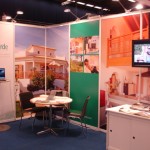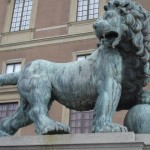AlmaVerde at the Buying Homes Abroad Show in Stockholm
Event date: 19 -20 September
In past years, the market for Algarve leisure real estate has been propelled by the British and Irish, but the recent demise of sterling and the plight of the Irish economy have prompted developers to start looking in other directions.
Scandinavians have not been buying Algarve property in numbers, but there is anecdotal evidence that they are now becoming more active. There are now flights to Faro on Norwegian Air Shuttle from the capital cities of Oslo, Stockholm and Copenhagen, and Scandinavian currencies have remained relatively firm against the euro.
So it seemed opportune when Open Media, publisher of Essential Algarve, came to an agreement with Fair Media, the leading Scandinavian promoter of property shows, and sent out an invitation to developers to participate in an Algarve Pavilion at the Buying Homes Abroad Show in Stockholm, which took place over the weekend of 19 — 20 September.

AlmaVerde stand
By showcasing a number of the Algarve’s leading developments on a large, well-designed stand, and by simultaneously distributing a Swedish edition of Essential Algarve, Open Media hoped to go a long way towards increasing the profile of the Algarve in the Swedish market.
In the initial presentation, the promoters claimed that a similar single-destination Pavilion organized some years previously had helped to push Thailand to the top of the list for Swedish buyers. My thinking was that, as at least 80% of overseas property buyers go for a short-haul destination, and if a long-haul destination like Thailand can get to the top of the list, then surely the Algarve must be due for its share of interest?
Moreover, AlmaVerde is a unique development, on the border of a vast Natural Park, with many awards for its high-quality, energy-efficient construction, making prominent use of timber from sustainable sources, as well as other natural materials. Surely all this would resonate well with the Swedes?
Although the Scandinavians are excellent linguists, we sought to further increase the chance of success by enlisting the help of a charming Swedish-speaking friend from the Algarve to help overcome any language difficulties, and to help forge relationships.
The design of the 180 m2 stand, situated right at the centre of the exhibition, projected a strong identity for the Algarve, with imagery of Lagos marina and an Oceanico golf course at one end. This played to the twin passions of the Swedes: boats and golf. The 24,000 islands of Stockholm’s archipelago fan out towards the Baltic Sea, with central Stockholm itself built on the innermost 14 islands. When they are not messing about on boats, the Swedes love to play golf. Out of a population of 9 million, over 600,000 are registered members of golf clubs.
At the other end of the stand was a map of the Algarve, showing the locations of all the exhibitors, and less prominent map showing the location of the Algarve in relation to Europe, and the flight distances to the major European capitals.
Openings at each end led to a common central area, where Open Media were giving out the magazine, and there were three openings on either side, with an exhibitor positioned on each side of the opening. We were “teamed” with Dunas Douradas Beach Club. Behind us was Longevity Wellness Resort in Monchique, who were opposite the Algarve Tourism Association.
Other worthy exhibitors included Marina de Lagos, Oceanico, Pine Cliffs, Newlyn Portugal, Vale da Ribeira and Porta Grande.
The first discouraging sign was the Stockholm weather. Far from being a chilly, rainy autumn weekend, the sun shone bright in a clear blue sky. Dreams of sun, sea and golf are no substitute for the real thing. The local AB+ target buyer, if not happily sailing out to his or her red-painted island summer house, would likely be found teeing up on one of the 50+ local golf courses.
This was borne out by the attendance statistics. Despite an advertising spend in the local press of 160,000 euros, the total visitor count over the two days came in at 3,500, down 50% from the peak a couple of years previously.
The next setback was the low level of interest in the Algarve. This was not due to any shortcoming in the destination itself. After all, Spain, Italy, the south of France, and even Malta, all appeared to be popular. Indeed, if little, over-crowded Malta, with its uncomfortably hot summers, wet winters, and almost total absence of beaches, could win business, surely the Algarve was well-positioned?
The problem was in the maturity of the market. As a result of a number of years of active local representation, there was already considerable momentum behind the well-established destinations, and most visitors already had a good idea of where their interests lay.
Swedish winters are long and harsh, and, despite the long-haul travel times, many Swedes like to get away for a longish winter break of three or four weeks to a tropical clime where they can live and be treated like royalty at modest cost. Thailand fits this bill precisely. Brazil is also a good fit, and was attracting interest.
Seminars were run on each of the featured destinations, with question and answer sessions about buying and living there. Thailand drew a capacity crowd of 200, and even Spain pulled in 150. The seminar on the Algarve drew a total of 12, several of whom drifted out during the presentation.
The lady from the Algarve Tourism Association apparently had some very pressing work to do, as each time we passed her, she was working on her laptop with an invisible “do not disturb” sign.
The few locals who drifted our way had some odd comments:
“You can’t get roast kid like you used to”
“Portugal is too cold”
“If you buy a property, how do you know whether you are paying the correct market price?”
The show organizers convened an exhibitors’ meeting at the end of the first day, to talk about their marketing and announce the first day’s attendance figures. They had thoughtfully given out a voucher to each exhibitor that could be exchanged for a gin and tonic. But everyone knows that there is no such thing as a free gin and tonic, and this one was looking very expensive.
It even appeared that Cirque du Soleil, who had scheduled four performances in the main Globe Arena, could not compete with the fine weather, and cancelled their final show.
On the second day, we focused our efforts on other exhibitors and on opportunities to forge relationships with intermediaries. This looked to be far more productive, although it is too early to be definitive. We also met with one or two couples who were actually familiar with the Algarve and interested in a villa purchase.

Gaurding the royal palace-Can we have our ball back?
The three of us did enjoy a couple of traditional Swedish meals in the old town of Stockholm, including an excellent slow roast elk, as well as the obligatory meat balls. The standard of food and service was generally very good.
We were also relieved that the food on the TAP return flight to Lisbon was supplied by a
Stockholm rather than Lisbon-based caterer. The food on the outbound flight had been inedible. It’s one thing eating well-prepared bacalhau, Portugal’s traditional dish of dried, rehydrated and cooked codfish, in a nice sauce. It’s quite another when it’s been allowed to cool, then reheated and dried out again in an airplane microwave, then served with stewed cabbage and mash (probably from powder). Perhaps that’s what Mrs. Algarve Tourism was doing at the show, busy writing a letter of complaint to TAP.
John Tranmer



